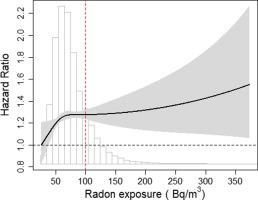Environment International ( IF 10.3 ) Pub Date : 2022-07-26 , DOI: 10.1016/j.envint.2022.107437 Seçkin Boz 1 , Claudia Berlin 2 , Marek Kwiatkowski 1 , Murielle Bochud 3 , Jean-Luc Bulliard 3 , Marcel Zwahlen 2 , Martin Röösli 1 , Danielle Vienneau 1

|
Background
Radon is a radioactive noble gas naturally found in the earth crust that can accumulate in buildings. In addition to lung cancer, alpha particles emitted by radon may contribute to the risk of skin cancer. We evaluated the association between residential radon exposure and skin cancer mortality, over a fifteen year period, taking residential ultra-violet (UV) exposure into account.
Methods
We included 4.9 million adults from the Swiss National Cohort. Hazard ratios for melanoma mortality were estimated using Cox proportional hazard models (20+ years old; follow-up 2001–2015). Long-term modelled residential radon and ambient UV exposures were assigned at baseline, and included together in the Cox models. With age as a time scale, models were adjusted for calendar time, sex, marital status, education, mother tongue, socioeconomic position, and occupational environment with potential for UV exposure. Age specific hazard ratios were derived. Effect modification, sensitivity analyses and the shape of the exposure response, as well as secondary analysis using other outcome definitions, were investigated.
Results
During follow-up (average of 13.6 years), 3,979 melanoma deaths were observed. Associations declined with age, with an adjusted hazard ratio per 100 Bq/m3 radon at age 60 of 1.10 (95% CI: 0.99, 1.23). The dose–response showed an approximate linear trend between the minimum and mean radon exposure of 75 Bq/m3. Having outdoor occupation significantly increased the risk of melanoma mortality associated with UV exposure compared to indoor jobs. Analysis restricted to the last five years of follow-up showed similar results compared to the main analysis. Similar associations were found for mortality from melanoma and non-melanoma skin cancer combined.
Conclusion
With double the follow-up time, this study confirmed the previously observed association between residential radon exposure and melanoma and non-melanoma skin cancer mortality in Switzerland. Accumulation of radon indoors is preventable and of public health importance.
中文翻译:

对瑞士居民住宅氡气和紫外线暴露与恶性黑色素瘤死亡率的前瞻性队列分析
背景
氡是一种天然存在于地壳中的放射性惰性气体,可以在建筑物中积聚。除了肺癌之外,氡气释放的α粒子也可能增加患皮肤癌的风险。我们评估了十五年期间住宅氡气暴露与皮肤癌死亡率之间的关联,并将住宅紫外线 (UV) 暴露考虑在内。
方法
我们纳入了来自瑞士国家队列的 490 万名成年人。使用 Cox 比例风险模型估算黑色素瘤死亡率的风险比(20 岁以上;随访 2001-2015 年)。长期建模的住宅氡气和环境紫外线暴露在基线上分配,并一起包含在 Cox 模型中。以年龄为时间尺度,根据日历时间、性别、婚姻状况、教育程度、母语、社会经济地位和可能接触紫外线的职业环境对模型进行调整。得出了特定年龄的风险比。研究了效果修改、敏感性分析和暴露反应的形状,以及使用其他结果定义的二次分析。
结果
在随访期间(平均 13.6 年),观察到 3,979 例黑色素瘤死亡。关联随着年龄的增长而下降,60 岁时每 100 Bq/m 3氡的调整后危险比为 1.10(95% CI:0.99,1.23)。剂量反应显示75 Bq/m 3的最小氡气暴露量与平均氡气暴露量之间呈近似线性趋势。与室内工作相比,户外工作显着增加了与紫外线暴露相关的黑色素瘤死亡风险。仅限于过去五年随访的分析显示与主要分析相似的结果。黑色素瘤和非黑色素瘤皮肤癌的死亡率也存在类似的关联。
结论
这项研究的随访时间增加了一倍,证实了之前观察到的瑞士住宅氡气暴露与黑色素瘤和非黑色素瘤皮肤癌死亡率之间的关联。室内氡气的积累是可以预防的,并且具有公共卫生重要性。











































 京公网安备 11010802027423号
京公网安备 11010802027423号